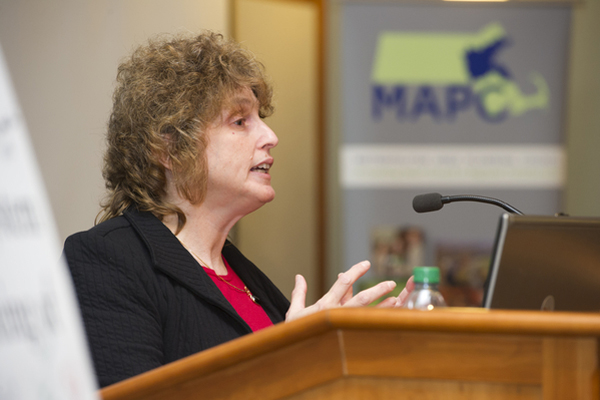Roadmap to a sustainable transportation system

Stephanie Pollack, associate director of the Dukakis Center for Urban and Regional Policy in Northeastern’s School of Public Policy and Urban Affairs, noted a decades-long shift in public thinking about the environmental impact of energy consumption. Now, she said, a similar movement must be directed toward sustainable transportation.
“We haven’t been able to make that paradigm shift on transportation because we don’t know what the transportation equivalent of the megawatt is,” Pollack said.
To this end, Pollack has developed a new framework for building a more equitable and sustainable transportation system in Greater Boston. The Dukakis Center report, “Staying on Track,” is based on an extensive collection and analysis of a broad range of data and is designed to shed light on how the system does or does not work.
Pollack outlined the first-of-its-kind project on Monday at the Metro Boston Consortium for Sustainable Communities fall meeting, which took place in Northeastern’s Curry Student Center Ballroom. The consortium is coordinated by the Metropolitan Area Planning Council, a regional planning agency serving more than 100 cities and towns of Metropolitan Boston.
The sweeping analysis comprises three dozen proposed indicators and benchmarks that could be used to explain the complicated set of demographic and economic factors driving the region’s travel patterns. Those indicators and benchmarks aim to address what Pollack identifies as nine attributes of a sustainable transportation system: the system’s condition, funding sustainability, transportation options, accessibility, affordability, safety, convenience and sustainability.
In Monday’s presentation, Pollack cited several daunting pieces of data. She called attention to the state transportation department’s $240 million shortfall to operate its highway system in the 2014 fiscal year and a fleet of MBTA’s Orange and Red Line vehicles that are beyond their intended lifespan.
Not all the data, however, were gloom and doom. Pollack pointed to a dramatic rise in the number of people who commute to work via bicycle, for example, and noted the city’s efforts to install more than 50 miles of bike lanes and launch a bike-sharing program. She also said that MBTA ridership is steadily rising, though she added that the T doesn’t have the financial capability to make the necessary investments to match this growth.
Following this baseline data over time, she said, will help government officials, transportation experts and lawmakers develop effective long-term policies and determine whether transportation systems are heading in the right direction.
Pollack arrived at several conclusions. She noted that the state’s current transportation system is neither well maintained nor sustainably funded, though baseline travel patterns reflect relatively lower amounts of driving and greater amounts of transit use compared to peer metro areas and states. Pollack also found that travel options that support sustainable mobility are not distributed evenly across communities, which, she said, affects equitable access to jobs across the region.
Following a period for public feedback, a final transportation report will be released later this year.
“There is no sustainability without transportation,” said Pollack, noting that transportation is the largest and fastest-growing segment of greenhouse gas emissions in Massachusetts.
The Dukakis Center is also involved in two other transportation related projects: Scoring to Understand Sustainable Transportation Attributes and Indicators, or SUSTAIN, which scores the state’s 351 cities and towns based on 10 attributes of environmental sustainability; and eTODscore, a database and rating system for equitable transit-oriented development based on neighborhoods with MBTA stations and key bus routes.





